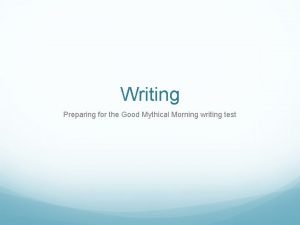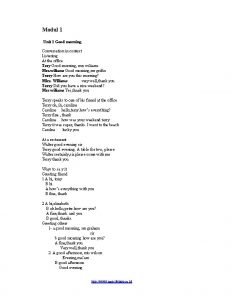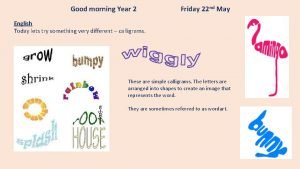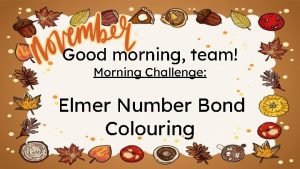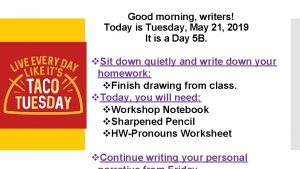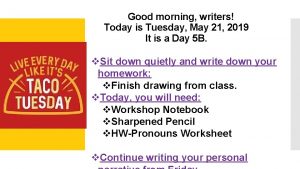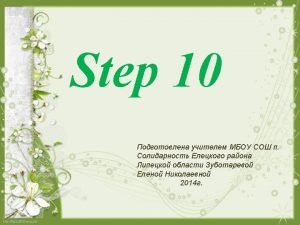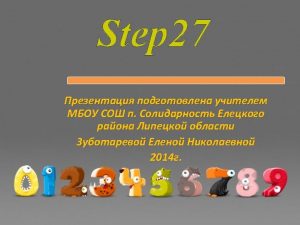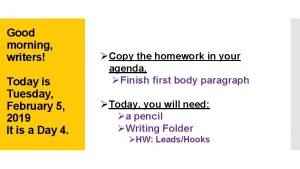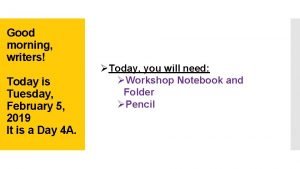Good morning writers Today is Tuesday May 28


















- Slides: 18

Good morning, writers! Today is Tuesday, May 28, 2019 It is a Day 3 A. v Homeroom Reminders: v Lake Compounce Permission Slips are due. v Spring Bill $ is due June 7. v. Copy homework into your agenda: v Grammar Study Guide due Thursday v Grammar Quiz is Friday v Optional: Re-submit DW by Friday v. Today, you will need: v. Workshop Notebook v. Sharpened Pencil

Good morning, writers! Today is Tuesday, May 28, 2019 It is a Day 3 A. v. Copy homework into your agenda: v Grammar Study Guide due Thursday v Grammar Quiz is Friday v Optional: Re-submit DW by Friday v. Today, you will need: v. Workshop Notebook v. Sharpened Pencil

Graded Descriptive Writing Passage ◦Please review your graded Descriptive Writing Passage and Rubric. ◦If you would like to revise and/or edit your piece and re-submit it for an improved grade, it is due Friday. ◦Plan to see me during L Block to discuss how you will make these improvements.

PERSONAL NARRATIVE SESSION 3 2019

I CAN… …write about a small moment from my point of view, in order for readers to experience it from the same perspective.

Connection ◦ In our first three writing sessions, we learned that there is more than one way to generate ideas for personal narratives. ◦ Making lists ◦ Drawing a sketch of a place ◦ Creating a chart of firsts, lasts, and times we have realized something ◦ Writers, including all of you, are incredibly brave people—they take risks each time they put their pen to paper and tell a story!

Teaching Point ◦ As writers of true stories, you already know how important it is to write from inside the story moment, telling the story as it unfolds. ◦ Today I will teach you that: ◦ Writers need to be especially careful about telling the details of the story exactly the way the narrator perceived them at the moment.

Teaching ◦ Point of View-the way the narrator tells the story through his or her eyes and other senses. The details of the scene need to be the ones that the narrator can take notice of—otherwise, they don’t belong there. v. Example—When I think about writing inside a point of view, I always think back to when I was changing my squirmy little boy’s diaper.

Teaching ◦ My First Draft: ◦ I was still at the couch, my son squirming beneath me, when my husband put the box on the kitchen table and then, peeling off a long strip of tape and pulling back one of the flaps, looked in on a jumble of photos, with little photo albums scattered throughout. The photos showed my husband me when we were in high school—they were the ones we’d

Teaching ◦ My Second Draft: ◦ I was at the couch, my son squirming beneath me, when my husband walked into the kitchen and dropped a heavy carton on the kitchen table. I heard him rustling about, and then I heard him mutter, “Unbelievable, just unbelievable. ” He looked up from across the room and called, “Remember all those lost photos from high school? They’re all here!”

Active Engagement Thumbs Up or Down? ◦ Let’s practice noticing when a writer slips out of his or her perspective by mistake. ◦ As you listen to my draft, decide, “Is the point of view consistent? ” ◦ If yes, give me a thumbs up. ◦ If no, give me a thumbs down.

Thumbs Up or Down? I made my way slowly toward the front of the line, as one by one, kids in soggy bathing suits sat at the edge of the water slide before disappearing suddenly down the chute. I was next in line and the thumping in my heart was almost audible. “I can do this, ” I thought to myself. I took one step forward… I carefully sat down, feeling the cold rush of water beneath me. My hands gripped the edges of the slide. “Ready? ” the attendant asked. “I think so, ” I replied, still unsure. My cousin waited at the bottom wondering what was taking me so long. Soon I was at the edge of the slide. I leaned forward just enough to peer down below at the small, blue rectangle of a pool dotted with the heads of swimmers below. I shut my eyes quickly, dizzied from the height.

How to Write Powerful Personal Narratives ◦ Think of a person, place, or moment in your life (maybe a first or last time, or a time when you realized something) that matters, and write a story about it. ◦ Focus on one episode, write with detail (don’t summarize a stretch of time). ◦ Help readers picture the episode—a small action ◦ Climb inside the moment and write within the and exact narrator’s point of view.

Link Remember the importance of maintaining the narrator point of view as you tell your story. Take thirty seconds to decide on the powerful Small Moment story you’ll begin drafting in today’s workshop. Travel back in time, back into your point of view, at that time. Picture it in your mind. Zoom into the tiny details of the place. What are you saying? What are you doing? Classwork— 1 -2 pages—You’ll move forward with your personal narrative, or begin a new personal narrative.

Mid-Workshop Writers pick and choose which details to include in their writing. They don’t just slap any ol’ details or any ol’ dialogue onto a page. Instead, they make calculated decisions about what to include. You need to pick the details that help the reader understand the meaning behind the story!

Student Example 1. Read 2. Turn & Talk: What do you think?

Student Example

Questions to Ask Yourself as You Edit 1. Does this make sense? Are any words or parts missing? 2. Are all my sentences complete? Have I checked for run-ons and fragments? 3. Have I used correct capitalization (for names and the beginning of sentences)? 4. Have I used commas and quotation marks for dialogue? 5. Have I checked to see that all my verbs and subjects agree? Are my verbs in the right tense (past, present, future)? 6. Do the words all seem to be spelled right? Do they look right? Have I checked any I am uncertain of? 7. Have I checked for frequently confused words (to, too, two, there, their)?
 Hello teacher good afternoon
Hello teacher good afternoon Good morning professor english
Good morning professor english Good afternoon teachers
Good afternoon teachers Good morning class
Good morning class Good morning i am fine
Good morning i am fine Good morning images with safety
Good morning images with safety Good mythical evening
Good mythical evening Hey google good afternoon
Hey google good afternoon Good afternon animado
Good afternon animado Good morning, students
Good morning, students Good morning my students
Good morning my students Good morning students how are you today
Good morning students how are you today Good morning students how are you
Good morning students how are you Good morning campers today's challenge is simple
Good morning campers today's challenge is simple Winter mad libs
Winter mad libs Good morning in indirect speech
Good morning in indirect speech Good evening conversation
Good evening conversation 2 may good morning images
2 may good morning images Good morning campers today's challenge is simple
Good morning campers today's challenge is simple






